Opatija, this elegant tourist destination, lies at the centre of the Riviera with the longest tradition of tourism in Croatia. The very attractive geographic position, enabling its warm seas to be quickly reached from many cities in Central Europe (only about 500 km from Milan, Vienna and Münich), lush green scenery and a pleasant climate (45° 20’ north latitude) were some of the main reasons for its beginning and the quick development of its tourism at the end of the 19th century.
Built mainly at the turn of the 20th century, Opatija has remained in complete harmony with Nature right up until the present day. Well-maintained public gardens, the illuminated 10-km-long coastal promenade known as the "Lungomare", well-kept beaches and fountains provide a stunning backdrop for the villas and hotels that cater comfortably for up to 10.000 guests.
Due to a relatively constant temperature (winter average 7.0 °C, summer average 21.9 °C), high air pressure and constant circulation of air, the climate in Opatija is relaxing and refreshing. The contrasts of sea and mountains, green parks and blue sea, old buildings and modern comforts, noisy entertainment venues and quiet destinations for excursions all combine to make Opatija and its surroundings a very attractive tourist resort at any time of the year.
The tourist offering of Opatija includes its congress facilities (over 50 meeting rooms with capacity up to 900 delegates), 15 indoor swimming pools, wellness programmes, a casino, discotheques, a Open-air theatre with seating for 2.000, carnivals, festivals, and opportunities for shorter trips to nearby surroundings or all-day excursions to the Plitvice Lakes or Risnjak National Park, or even to Venice in Italy.
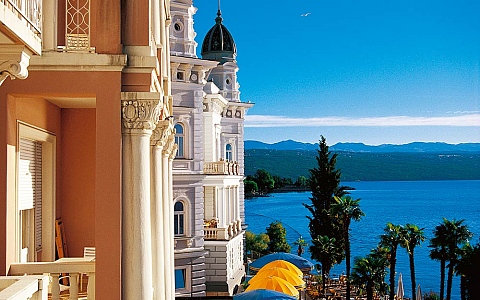
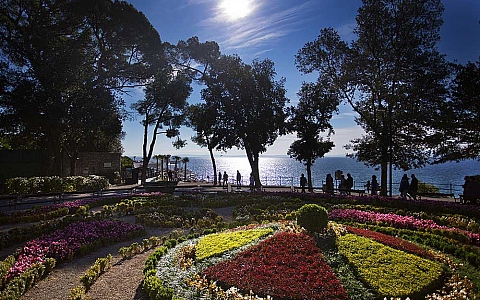
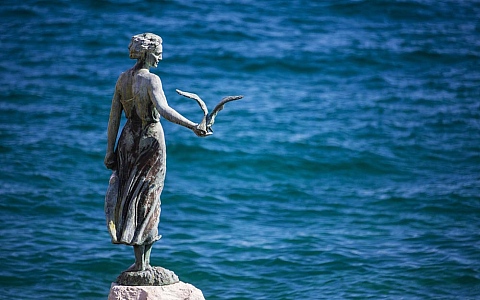
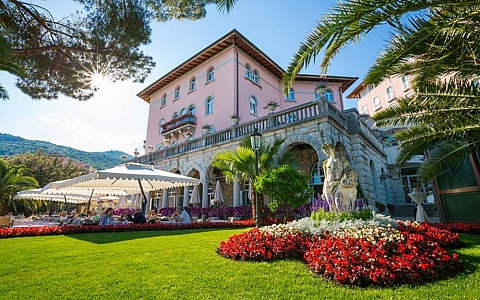
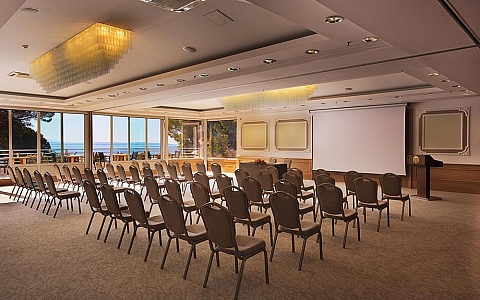
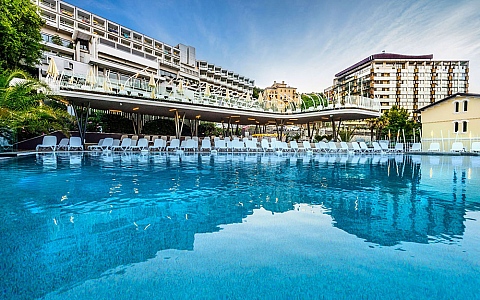
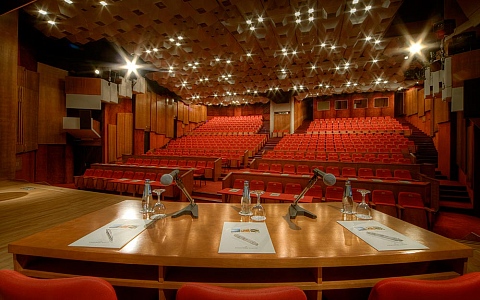
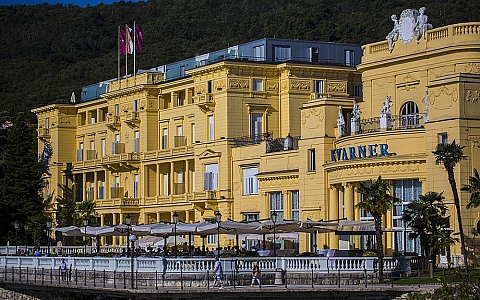
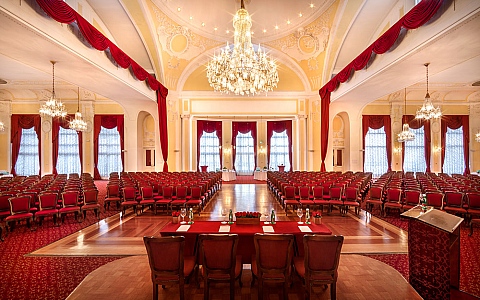
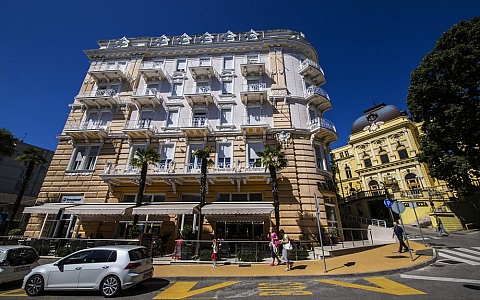
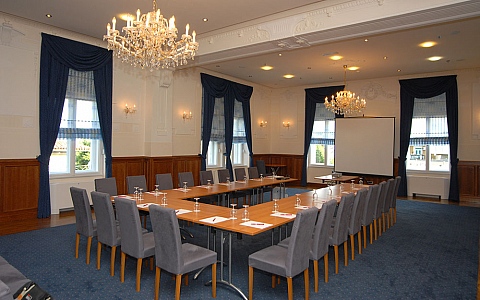
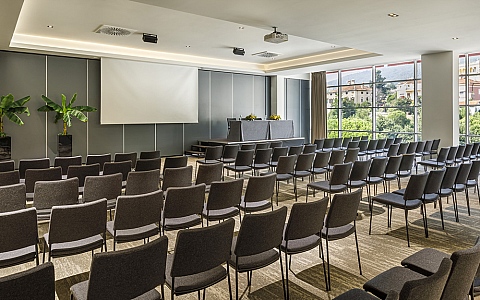
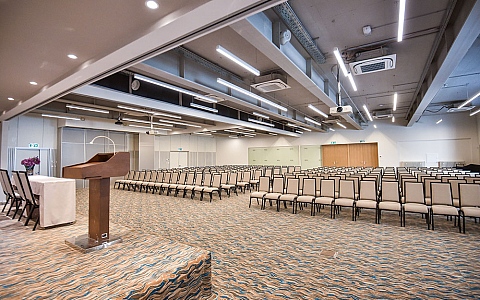
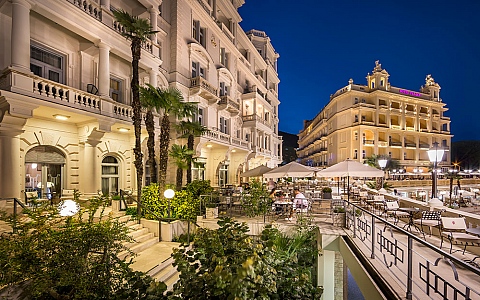
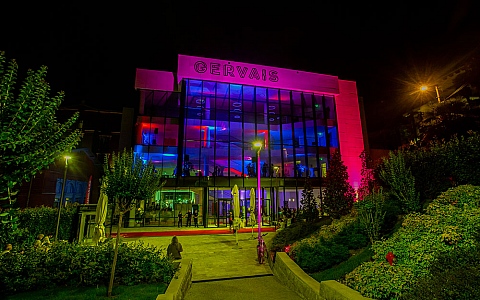
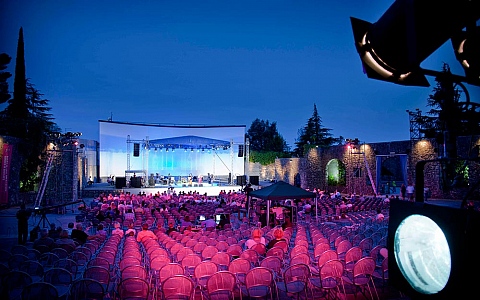
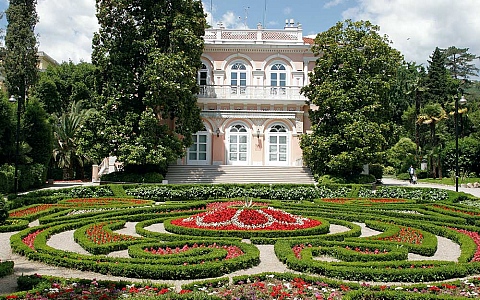
Villa Angiolina
This is the building that certainly marked the beginning of the tourist epoch in the history of Opatija. Pending its building in 1844 (actually a reconstruction of an older building owned by baron Haller von Hallerxtein), Opatija was relatively large settlement with about 120 houses, clustered mainly around plots further away from the sea coast and chiefly oriented towards fishing and seafaring. With the arrival of Iginio Scarpa, a patrician from Rijeka, and building of his summer house Angiolina (named after Scarpa’s then already deceased wife, originating from the Sartori family), Opatija opened her doors to a whole line of guests and passengers, among whom it is noteworthy to mention the Austrian empress Mary Ann, the botanist Heinrich Noë, the Croatian ban Josip Jelačić and others who in their enthusiasm for the local vegetation and climate spread the fame about Opatija and thus prepared the ground for the future health resort.
Saint James’s Church
Most probably built in 1420, as a colony of Benedictine refugees from the Friulian monastery of Saint Peter in Rožac (San Pietro di Rosazzo), the entire settlement will later be named after this abbey. Today very little has been preserved of its original appearance: in 1506 abbot Šimun built or reconstructed the church, according to the inscription above the portal; near the end of the 18th century the church was thoroughly renovated, and in 1930 it was considerably expanded. Among its attraction, it houses a replica of one of Mestrović’s relievos.
Maiden with a seagull
Recognizable symbol of the town and one of most photographed sculptures in Croatia. Elegantly standing on the reef beside Lungomare promenade, it intrigues all passengers with her interesting story. Before in its place stood the statue “Madonna del Mare”, which was erected to keep vigil over the soul of count Arthur Kesselstadt, who vanished, not far off from that promontory swallowed by the pre-Easter waves in 1891. The original statue is placed in Croatian Museum of Tourism in Villa Angiolina, and a gilded variant of the Madonna can be seen in front of Saint James church.
Hotel Kvarner
The oldest hotel on the east coast of Adriatic was opened in 1884 as the first luxury property in Opatija. Initially it was designed as a sanatorium for pulmonary diseases for nobility and royal family members. After the spa was destroyed by fire, in 1913 beautiful Crystal Ballroom was built and from then it became one of the most famous locations in town. Decorated with beautiful crystal chandeliers, the Ballroom hosts numerous cultural and entertainment events, and various celebrations.
Lungomare (Franz Joseph I Promenade)
Between lush parks and magnificent villas on the one side, and foaming waves on the other, lies the Lungomare, one of the best-known attractions of the Opatija Riviera. This twelve-kilometre-long, hundred-year-old seafront promenade runs along the coast from Volosko past Opatija all the way to Lovran. Shaded by laurel and holm oak, the Lungomare offers the perfect opportunity to become acquainted with the local history or see first-hand some of the cultural monuments, such as the birthplace of the scientist Andrija Mohorovičić in Volosko or the Girl with the Seagull statue, a symbol of Opatija
Park Angiolina and St. James Park
The central park of Opatija is a horticultural monument at the area of 3.64 hectares. It is divided into 60 fields with 150 plant species. Many of them originated in the distant locations and are not typical for this climate. There is information in historic documents which testify the design of the park in the period from 1845 to 1860, in the vicinity of Villa Angiolina, which was the property of Iginio Scarpa, a great nature lover. In that part there are many plants which were brought from Japan, China, South America, Australia and other parts of the world. Among the interesting species there is the Japanese camellia (Camellia japonica), which has with time become the renowned symbol of Opatija. Today the park is divided into two units, one near the church - St. James Park and the other near Villa Angiolina - Park Angiolina.
Croatian Museum of Tourism
The Croatian Museum of Tourism is a specialized national museum institute founded in 2007 that collects, preserves, researches and presents the material and non-material heritage of a touristic content. Among the fundamental tasks of the institution is the collection of data with regard to all relevant sources and potential museum exhibits which are important for the history of Croatian tourism. The Museum disposes of two buildings: Villa Angiolina and the “Juraj Šporer” Arts Pavilion.
Učka Nature Park
Opatija's hinterland is the perfect place for nature lovers and fans of outdoor activities, but also those interested in learning more about the local history and cultural heritage. The villages in the surrounding area have fascinating stories from the past, and the magnificent Mount Učka, protected as a nature park, ascends directly from the coast to a height of 1,401 metres above sea level and is a great challenge for hikers and mountain bikers alike.
Within only a couple of hours, any one of the park’s numerous hiking trails will take you from the picturesque Mediterranean architecture of the coastal cities through the wooded slopes of Učka mountain up to its highest peak, Vojak, at a height of 1,401 meters. At the summit, a belvedere in the form of a medieval tower offers breathtaking view in all directions: the Istrian peninsula, the islands of the northern Adriatic, the mountains of Gorski Kotar, Venice, the Italian Alps...
View other attractions in Opatija here
The Opatija Convention & Incentive Bureau, as part of the Opatija Tourism Office, is a non-profit organisation aimed at promoting Opatija as a renowned Croatian convention and incentive destination. The Bureau provides independent information free of charge about the possibilities of organising conventions and incentive events in Opatija and its surroundings.
Activities of the Bureau include daily communication with service providers in the town, event organisers, and potential clients. The Bureau also supports the events that take place in Opatija by providing information and dealing with any issues that might be of concern for the event.
International activities of the Bureau include participation in international exhibitions specialising in meetings and incentives (IMEX, EIBTM), where it promotes Opatija's convention and incentive offer. The Opatija Convention & Incentive Bureau is full member of ECM - European Cities Marketing.
The Opatija Convention & Incentive Bureau provides neutral, free-of-charge information to the organisers of conventions and incentive events in Opatija. Its main services include:
• venue finding
• hosting familiarisation trips and site inspections
• suggesting social programmes, pre- and post-convention excursions
• providing promotional material about Opatija
• assisting in PCO election
• bid assistance
Contact:
Convention Bureau Manager
Phone: +385 51 603 273
Fax: +385 51 271 699
E-mail: convention.bureau@visitOpatija.com
"Be introduced in Opatija", that has always been a matter of prestige and an enduring mantra. Opatija has always been a centre of the most important business, art and entertainment events.
Charming your guests is easier in Opatija, because Opatija has plenty of charm. This is an unwritten rule which has been valid for more than a century and a half. Major business events, spectacular concerts have always been at home in Opatija and on its famous stages - Open Air Theatre and the mythical Crystal Ballroom of Hotel Kvarner.
Opatija's long tradition as a convention destination and holiday resort is best illustrated by the fact that it was the venue for the Fourth Congress of Austrian Balneologists in 1904, and that in 1906 a book entitled Abbazia als Kurort (Opatija as a health resort) was published to mark the 60th birthday of Opatija's eminent doctor, Julius Glax. With more than 30 hotels, most of them rated with four or five stars, numerous restaurants and recreational facilities, entertainment programmes and events of various kinds, Opatija can today satisfy the needs of even the most demanding of congress organisers and delegates.
To the organisers of business meetings, Opatija offers all the advantages of a major convention destination combined with the enticing charm of a more intimate holiday resort. The area’s extensive experience and tradition in organising conventions, combined with modern quality accommodation, provide excellent foundation for organising various meetings and events.
Today, more than 125 years after the first congress, Opatija hosts more than 500 congresses, seminars, various meetings and events each year. Many of these are traditional and of national importance, but each time Opatija also hosts an increasing number of internationally relevant congresses. One of the reasons for this is undoubtedly Opatija’s favourable central position in the Alpe-Adria region, which includes the countries of Croatia, Slovenia, Italy, Austria and Hungary). Thanks to the modern motorway network, Opatija can today be easily reached by car in only several hours’ drive from all major centres of the region. More precisely, Opatija is within the radius of 5-hour-drive from some of the most important cities in South and Central Europe (Zagreb, Varaždin, Osijek, Split, Ljubljana, Maribor, Venice, Milan, Vienna, Budapest, Salzburg, Munich, Belgrade etc.).
Opatija can also be reached by air via five international airports (Rijeka-island of Krk, Pula, Zagreb, Ljubljana and Trieste) that are all within two-hour drive. By train, Opatija can be reached from the railway station in Rijeka (15 km away; for trains coming from the direction of Zagreb), and the railway station Opatija-Matulji (6 km; for trains coming from the direction of Ljubljana).
To the organisers of business meetings, Opatija offers all the advantages of a major convention destination combined with the enticing charm of a more intimate holiday resort. The area's extensive experience and tradition in organising conventions, combined with modern quality accommodation, provide excellent foundation for organising various meetings and events.
Opatija hosts more than 500 different meetings each year. Thanks to the wide range and diversity of its convention facilities, Opatija can host several events at same time. Many of these are traditional and of national importance, but each time Opatija also hosts an increasing number of internationally relevant congresses. Main conference facilities are situated in hotels.
Hotel Ambasador *****
Number of rooms: 243
Meeting rooms: 9
Largest meeting room: 473 m² / 500 seats
Total seats: 950
Amadria Park Hotel Milenij *****
Number of rooms: 96
Meeting rooms: 2
Largest meeting room: 173 m² / 220 seats
Total seats: 300
Grand Hotel Adriatic ****/***
Number of rooms: 315
Meeting rooms: 8
Largest meeting room: 750 m² / 550 seats
Total seats: 1.200
Hotel Admiral ****
Number of rooms: 200
Meeting rooms: 6
Largest meeting room: 170 m² / 130 seats
Total seats: 330
Amadria Park Grand hotel 4 opatijska cvijeta ****
Conference Park 25/7
Number of rooms: 291
Meeting rooms: 10
Largest meeting room: 340 m² / 450 seats
Total seats: 1.150
Amadria Park Hotel Royal ****
Number of rooms: 54 sobe
Meeting rooms: 1
Largest meeting room: 750 m² / 950 seats
Hotel Bristol by OHM Group ****
Number of rooms: 78
Meeting rooms: 3
Largest meeting room: 217 m² / 150 seats
Total seats: 185
Hotel Kvarner ****
Number of rooms: 82
Meeting rooms: 2
Largest meeting room: 655m² / 850 seats
Total seats: 900
Heritage Hotel Imperial ****
Number of rooms: 121
Meeting rooms: 2
Largest meeting room: 319m² / 200 seats
Total seats: 350
Hotel Palace Bellevue ****
Number of rooms: 221
Meeting rooms: 3
Largest meeting room: 99m² / 90 seats
Total seats: 190
Hotel Ikador*****
Number of rooms: 16
Meeting rooms: 1
Largest meeting room: 65 m² / 16 seats
Hotel Laurus ****
Number of rooms: 24
Meeting rooms: 1
Largest meeting room: 246 m² / 120 seats
Design Hotel Navis *****
Number of rooms: 44
Meeting rooms: 1
Largest meeting room: 64 m² / 40 seats
Keight Hotel, Curio Collection by Hilton *****
Number of rooms: 54
Meeting rooms: 1
Largest meeting room: 88 m² / 90 seats
Casino Hotel Paris ****
Number of rooms: 90
Meeting rooms: 1
Largest meeting room: 88 m² / 100 seats
Centre Gervais
Centre Gervais was opened in 2017 as a multifunctional centre for conferences, business and cultural events. Located centrally it is in walking distance from most of Opatija hotels. Centre offers main amphitheatre hall with 500 seats in auditorium and balcony. Small hall for 300 participants is located in the ground floor and can be divided into 3 smaller sections, too. Spacious lobby area is excellent exhibition space and networking area during coffee breaks. Basement floor is designed as club for concerts and entertainment events, completely isolated and has own entrance.
Villa AntonioLocated in the centre of Opatija, the Villa Antonio offers one amphitheater shaped hall of 152 m². Hall is equipped with beamer, projector screen and has free WIFI.
The Zora Cultural CentreThe Zora Cultural Centre is located in the town centre and can easily be reached on foot from nearly all Opatija's hotels. The building offers a multimedia hall (96 m²) suitable for lectures, seminars and receptions. It is located in vicinity of Centre Gervais so it can be used as additional space.
Open-Air Theatre Opatija's Open-Air Theatre was built in 1954 as one of the few open-air stages in the Mediterranean area. Since then, it has hosted numerous concerts, major opera and ballet stagings, and performances by some of the most eminent international artists.
Opatija's Open-Air Theatre, located near the town's harbour and Angiolina Park, can be reached on foot in a few minutes from most of Opatija's hotels with convention facilities. The large amphitheatre-shaped auditorium has a capacity of 2,500 seats. Opatija's Open-Air Theatre is a perfect venue for concerts and other events in the open air. In addition to the large central stage, there is another, small stage, suitable for more intimate concerts and performances. The small stage is also suitable for cocktail parties and similar events.
The Sports Hall Marino CvetkovićThe Marino Cvetković Sports Hall covers an area of 11,000 square metres and includes a large sports ground of 1,800 m2 that can be adapted depending on purpose with 1,217 seats, and a small sports ground of 200 m2. The hall also includes additional amenities such as reception, locker rooms, meeting rooms, restaurant, terrace for VIP events, medical office, wellness centre (saunas, massages) and outdoor public square. In the basement is a parking garage with 137 parking spaces and 5 parking spaces for the disabled. Next to the hall there are 5 bus parking spaces.
The hall can host various sporting events (handball, basketball, volleyball, futsal, tennis, table tennis, gymnastics, badminton, box, wrestling etc.) and a variety of cultural, business, exhibition and entertainment programmes (concerts, exhibitions, fairs, conventions, congresses, business meetings).
Faculty of Management in Tourism and Hospitality
The Faculty is the holder of numerous professional and scientific projects both in the country and abroad, as well as the organizer of scientific and professional conferences and round tables. It comprises 8 halls that can be used for conferences, business, and cultural events.
Largest hall: 142 m² / 150 seats
Učka Nature Park
The new Poklon Visitor Center features a congress hall of 172 m², accommodating up to 80 participants. If needed, the hall can be divided into two separate sections. It is equipped with audio-visual technology (projector, screen, speakers, sound system).
Opatija and its surroundings offer plenty of opportunities for organising incentive and team-building programmes and excursions, regardless of whether you enjoy extreme sports, are interested in learning more about the area's rich history, or if you are a gourmet or wine connoisseur looking forward to tasting some of the region's specialities.
Spend a very special evening at a Viennese Ball in the original ambience of the Austro-Hungarian Empire, in the company of His Imperial Majesty and ladies and gentlemen dressed in historic costumes. The taste of delicacies from the imperial era and the sounds of the Viennese Waltz will transport you back in time to Opatija's bygone era.
For sport enthusiasts, the area's impressive coastal landscape offers several possibilities for sailing, diving in the crystal clear depths of Kvarner Bay, or enjoying the area's pebble and sandy beaches, secret coves, picturesque harbours and pristine nature.
If you love trekking or orienteering, you can start by exploring the trails in the Učka Nature Park and enjoying the area's marvellous landscapes with guided tours. To stimulate your sporting spirit, try to engage in some orienteering, and find control points using maps of the area, a compass or GPS devices. Mount Učka is ideal for caving and free climbing, or team competitions in the rocky karst landscape. Learn to descend by rope down a sheer cliff, or discover the magical subterranean world of the karst underground accompanied by an expert guide with all the necessary equipment.
If you are a fan of cycling, you can experience Kvarner's coast, highlands and mountains on more than 1,300 kilometres of marked bike trails. Thanks to the diversity of the landscapes and terrain, your ride will always be interesting and dynamic, whether riding alone, as part of an organised tour, or with expert guides.
Sea kayaking is almost like walking on the sea. Scan the surface of the sea, looking for dolphins, admire the impressive rocks and hidden caves, experience a most beautiful sunset. You don't have to be a professional athlete or particularly good rower.
While staying in Opatija, you can visit not only the town and its surroundings, but other parts of Croatia as well, to explore interesting natural landscapes or to learn more about the country's rich cultural heritage. Just to name few of them National Park Plitvice Lakes, Istrian Peninsula, islands Krk and Cres, Zagreb, Rijeka etc.
Gastronomy
James Joyce loved to spend his time in Opatija on the terrace of the Hotel Imperial, enjoying a cup of coffee and tasting the local specialities. The author of Ulysses and one of the most significant writers of the modern age was famous for his statement that he had had a good day when he had "written an entire sentence". It is therefore clear that he was a man dedicated to perfectionism. His satisfaction with the area's cuisine confirms the quality of the local food, which combines the seafood typical of coastal places that have a long tradition of fishing with the more hearty meals of the villages in the hinterland, which survived due to agriculture and raising livestock.
Such a combination, which will surely satisfy even the finest gourmet palate, paired with the excellent wines of the region, has made the Opatija Riviera a renowned destination for food lovers and a place that offers the largest number of top restaurants per capita in Croatia. The area's bars and restaurants, which perfectly combine the essence of Mediterranean cuisine with typical local ingredients, proudly bear the Kvarner Gourmet quality label, and many of them have received recognition from national and international gastro guides. The small local taverns, characterised by a traditional approach to cooking and a homely atmosphere, are always popular among the food nomads who want to explore all the secrets of the local cuisine, and are marked by the Kvarner Food quality label.
The chefs of the Opatija Riviera turn the fresh local ingredients, such as wild asparagus, Kvarner scampi or truffles, into culinary artworks distinguished by their delicate, exciting taste that will surely remain in the memory of each visitor.
Opatija riviera (Ičići, Ika, Lovran, M. Draga, Matulji, Kastav)
The sea has always been the main resource for the people of Ičići ever since the ninth century BC when the Liburnians (an Illyrian tribe) used to build their fast ships along these coasts and then sail to North Africa and Asia Minor. It is therefore no wonder that this ancient connection with the sea has been preserved right up to the present day. Today, Ičići is most famous for its attractive beach and one of the best marinas in the Adriatic.
Visitors to Ika can enjoy perfect peace and quiet – probably the most sought-after qualities on a holiday, and essential for escaping the stress of daily life. This small coastal town with a population of only several hundred is particularly proud of its fishing and shipbuilding traditions, which today make up part of the local tourism offer.
Lovran is the oldest settlement on the Opatija Riviera, built on the spot that the Roman patrician, statesman, general and cartographer Marcus Vipsanius Agrippa chose as his residence back in the 1st century BC.
Emerging from the spot where Mount Učka descends into the sea, Mošćenička Draga combines the best of both worlds. Sipar beach is one of the most beautiful in Kvarner. There are also many secluded spots along the coastal promenade, where one can enjoy the sea and sun on small natural beaches, away from the crowds and prying eyes.
The three bells on the Matulji coat of arms represent the local carnival tradition and the zvončari bell-ringers, who recently gained international recognition after being added to the UNESCO World Heritage List. A remarkable sight that will introduce visitors to the magic of local carnival customs is the pageant of strong men wearing huge bells at their waists, with frightening masks and stylised maces, walking from village to village along the ancient paths in the hinterland of Matulji.
The town of Kastav is the former administrative, economic and cultural centre of Istria and the littoral region. It is built on a 365-metre-high hill overlooking Kvarner Bay and offers magnificent views of the Opatija Riviera. The old town of Kastav, with its distinctive architecture, is today the venue of many interesting events.
Učka Nature Park
Its particular climate has in the past determined the way Mount Učka has developed. This mountain, whose slopes "dive" into the sea, is home to many endemic plant and animal species. Due to this biodiversity and the magnificent relief of the mountain, a great part of this area has been protected as a nature park. In ancient times, Učka was the cradle of civilisation in this area. Ten thousand years ago, it was inhabited by the first groups of nomadic hunters, which is attested to by the archaeological sites of Pupićina peć and Vela peć in Vela draga. In old Slavic mythology, Učka was depicted as the home of the gods and was a holy place for ordinary people. Every part of this mountain has its own stories that tell about the people, divinities, fairies, stunning natural scenery and interesting flora and fauna here. In addition, Učka Nature Park offers its more adventurous visitors plenty of excitement thanks to a well-designed programme and various sports and recreational facilities. The activities on offer include hiking, horse-riding, mountain biking, free climbing, caving, adventure racing, paragliding, or simply walking along dozens of kilometres of well-maintained educational trails.
The view from Učka's highest peak, Vojak, is particularly impressive. From an elevation of 1,400 metres above sea level, one can admire a stunning panoramic view of the Istrian peninsula and Kvarner Bay with its islands. In fair weather, the view extends as far as Venice in Italy.
Historic towns
Veprinac, Kastav and Mošćenice were once important fortifications on the Kastav manorial estate, which at that time stretched across the entire area of the present Opatija Riviera. Today, there are numerous sites of interest from different historical periods, from prehistory to the Middle Ages and modern times. Although this area has been continuously inhabited, many parts have not been researched and conceal interesting surprises. For example, recent research in the small Church of St. Anne in Veprinac revealed valuable Glagolitic graffiti. It can be said that many visitors who come to these ancient towns to explore their historic monuments actually participate in a kind of "treasure hunt", in which the discovery of a new site of interest is always a wonderful reward.
These three historic towns provide a perfect insight into the former way of life of this area. If you want to learn how people used to live here in the past, we recommend visiting the local ethnographic and historical collections of everyday items. You can even play an active part and experience first-hand the process of pressing olives and producing the finest olive oil in the ancient olive press (locally known as a toš) in Mošćenice, which is more than three hundred years old. You can also see what it felt like to be imprisoned in chains in the darkness of the dungeon in Veprinac, which was once reserved for serious offenders, or you can take a walk across Lokvina Square in Kastav, which is named after the Croatian word for the pond ("lokva") that in the past was used to collect water and where the local people in 1666 drowned Captain Morelli, who wanted to impose high taxes.
The Croatian Walk of Fame
The Croatian Walk of Fame project in Opatija was launched in 2005 by the Apriori Communications agency as a symbolic tribute to all the people whose sporting, scientific, cultural or artistic endeavours have contributed significantly to the worldwide promotion of Croatia.
Potential candidates for inclusion are nominated by the project's independent Nomination Board consisting of several noted public individuals. From the board's nominations, readers of the media sponsors then cast their vote to decide which two candidates (one living, one awarded posthumously) should have their stars included in the Croatian Walk of Fame.
Islands Krk and Cres
The island of Krk or The Golden Island, as it was called in ancient times, has many unique features and it is a voyage through time across the millennia of rich history. Today the island is a vibrant place offering well-thought-out tourist programs, modern amenities, extensive wine lists and great food made from local produce. Wherever you go – to the picturesque Glagolitic town of Vrbnik or Jurandvor where the famous stone tablet from the year 1100 AD was discovered in St. Lucy’s Church, to Malinska, Baška, Krk, Punat, Njivice and Omišalj or to the well-known islet of Košljun, you will discover ancient heritage interwoven into Krk’s dynamic present. Today the island is a vivid and conveniently located modern tourist destination.
If you enjoy unspoilt nature and love exploring the diversity of life Cres is the best place for you. Here you can watch Griffon Vultures fly, contribute to their protection by adopting one and discover the wondrous phenomenon of Lake Vrana. Cres is located in the northern part of Kvarner Bay with its southern side connected to the island of Lošinj by a lift bridge. There is an array of coves and shingly beaches scattered along its western and southern shores, while steep cliffs line the island’s north and south. In the northern sub-Mediterranean part there are high and dense forests of oak, hornbeam, elm and chestnut trees while the central and southern Mediterranean part is covered with rolling pastures and dense evergreen underbrush.
Gorski kotar
Gorski kotar, the wooded hinterland of Kvarner, is also an area well worth visiting. Less than an hour's drive from Opatija, this area features some extraordinarily beautiful sights, such as the Risnjak National Park covering an area of 64 km2 and including, among other sights, the wonderful 4.5 kilometre-long Leska educational trail. Not to forget the Kamačnik gorge, the Zeleni vir protected landscape, Lake Lokve, and Lake Bajer near Fužine.
Istrian Peninsula
Istria is indeed a feast for the eyes. Its streams flow to the sea through deep valleys and gullies which bring to mind the ancient local myths about giants. Rolling hills overlook the fields and valleys with little towns perched on the peaks, recalling some old paintings. The view is splendid: white-topped mountains, lush wheat fields, plateaux, valleys, vineyards and olive groves on hillsides, and, finally the sea. As you get to know Istria you will notice more and more enchanting details: church facades and portals, tiny village alleyways with their specific architectural touches, the babble of a stream, the blossoming cherries. Everything is warm–hearted and friendly here: nature, towns and people.